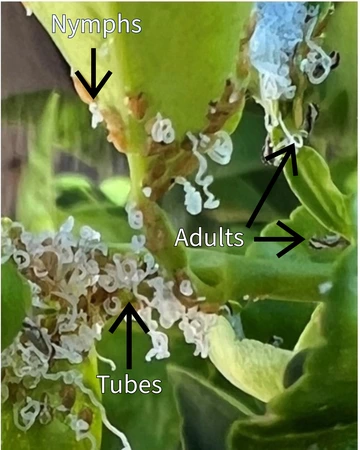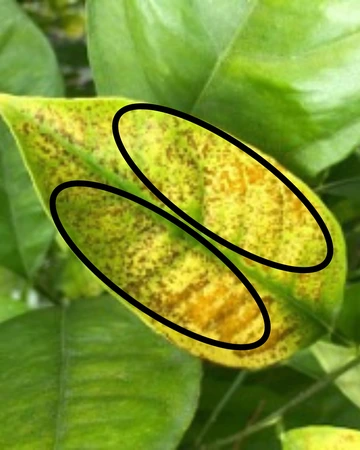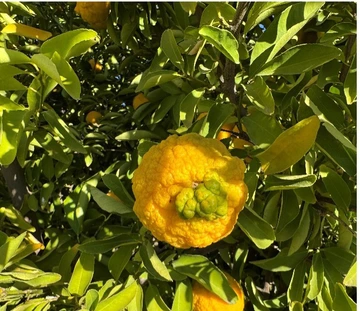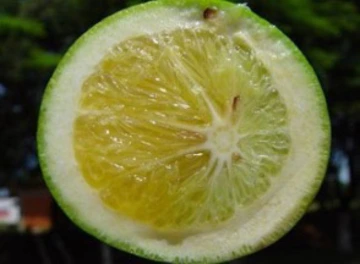Citrus greening disease, also known as Huanglongbing (HLB), was found for the first time in Nogales, Arizona in January 2025. Citrus greening is one of the most serious citrus diseases in the world; it has affected millions of citrus trees, damaged entire citrus industries, and there is no cure. A bacterium (Candidatus Liberibacter asiaticus) causes the disease that leads to leaf malfunction, root loss, reduced fruit quality and potential tree death. The Asian citrus psyllid (ACP) (Diaphorina citri) carries and spreads the bacteria as it feeds. ACP also feeds on the curry leaf tree (Murraya koenigii) which is grown in the low desert and Orange Jessamine, also known as China box and mock orange (Murraya paniculata). Both are adapted to the low desert. Since the disease is designated as a quarantine pest by the USDA and the Arizona Department of Agriculture (AZDA), authorities have established a quarantine zone near Nogales, which is a geographical area where insects and trees are sampled for the disease, outward movement of leaves, fruit and trees is prohibited and affected trees are being removed
The purpose of this publication is to help you: 1) Identify the ACP and its effect of feeding on leaves; 2) Consider the options for ACP control; 3) Identify citrus greening symptoms on the leaves and contrast them with leaf nutritional deficiency symptoms; 4) Identify citrus greening symptoms on the fruit, and; 5) Determine what to do if you think your tree has citrus greening disease.
Citrus greening only affects citrus trees and their close relatives. Citrus greening is not harmful to humans.
Jump To:
ACP Identification
The adult ACP is a small insect, about the size of a pencil lead. It prefers to feed on the softest leaf tissue, which is why it can be most often found on the new leaves or “flush” (Fig. 1). The adult inserts its “straw-like” mouthparts into the leaves to feed on the plant sap. As it feeds, the bacteria pass from insect to tree and vice versa. The adult will often sit on its “elbows” on the edges of the leaves with its hindquarters pointing diagonally outwards. ACP adults prefer to feed on the lower leaf surfaces and jump when startled, so they are sometimes difficult to see or photograph. Both feeding position and jumping are useful characteristics for identification. The edges of leaves where there has been feeding are often notched or “pleated” (Fig. 2).
The immature ACP (known as a nymph) is smaller than the adults. They are flattened and range from cream colored to yellow, with red eye spots. Nymphs also feed on the most tender leaves and can transfer the citrus greening bacteria. Nymphs will expel the plant sap that they cannot use through tiny white waxy tubes which extend outwards from their bodies. The presence of the tubes is often characteristic of a group of ACP (Fig. 3).
ACP Control
Both conventional and organic contact insecticides or systemic insecticides could be used to control ACP. Many can be found at the local nursery. Despite that fact, the following should be considered:
- If your location is in the USDA quarantine zone, the AZDA will hire professionals to spray the trees with contact insecticides at no cost to you. It is not recommended that you spray your trees, as this would be overuse of pesticides and may lead to insect resistance.
- If you are not in the quarantine zone, it is not recommended to control ACP in urban settings where citrus greening disease does not exist. This is because damage due to ACP feeding alone is negligible and overuse of insecticides may lead to resistance. Additionally, for a spray to be effective, all the trees in an area such as a neighborhood must be treated with insecticide at about the same time. Otherwise, ACP from nearby untreated trees will simply fly to treated ones and re-establish populations.
Appearance of ACP or signs of feeding do not necessarily indicate that citrus greening is present. As of May 2025, ACP have been found throughout the citrus growing region of Southern Arizona, yet, at the time of publication, citrus greening has only been found in Nogales.
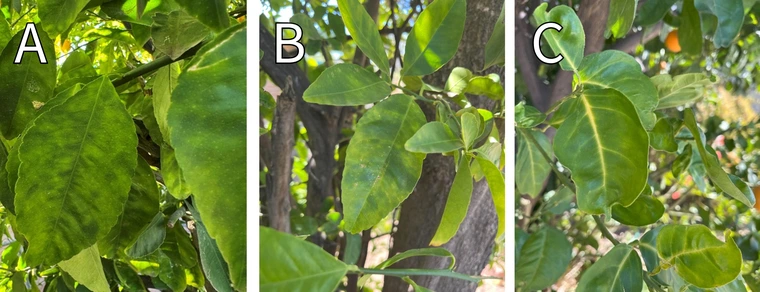
Figure 4: Citrus greening leaf symptoms in Nogales, AZ. Note mottled pattern in A and B and yellow midvein in C.
J. Legg, Arizona Department of Agriculture
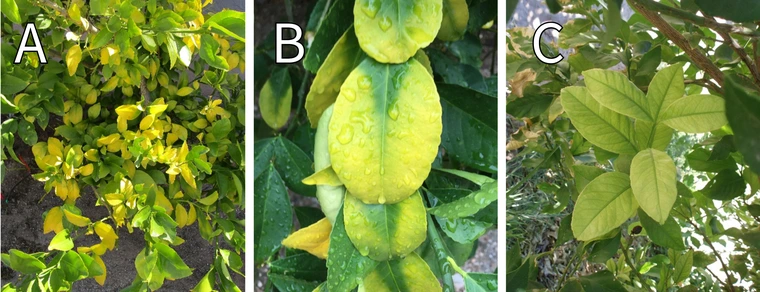
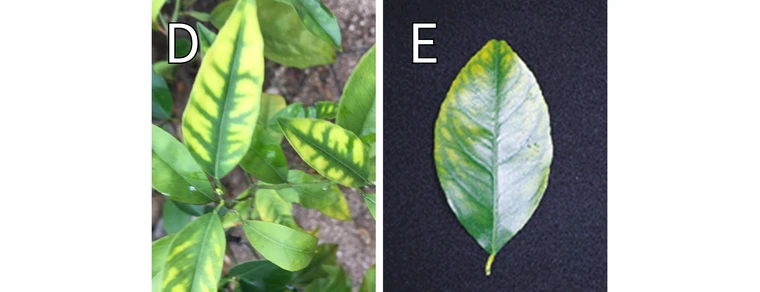
Figure 5. Citrus leaf nutritional deficiencies: A) – Nitrogen, B) – Magnesium, C) Iron, D) – Zinc and E) – Manganese
Citrus greening leaf symptoms, leaf nutrient symptoms and how to tell the difference
When the bacteria enter the tree, they first cause damage to the phloem, which is the tissue that moves sugars (food) internally from the leaves to elsewhere in the tree. As the phloem becomes more damaged and blocked, the tiny organs (chloroplasts) that carry out photosynthesis in the leaves begin to die and the leaves turn yellow in an asymmetrical blotchy pattern. Also, the leaf veins become yellow rather than green, and they become prominent and noticeable. Leaf blotchy mottle and yellow prominent veins are distinct characteristics of citrus greening infection (Fig. 4 A-C). Citrus greening symptoms cannot be reversed with fertilizer or watering.
Leaf nutritional deficiency symptoms, such as nitrogen, magnesium, iron, zinc, and manganese, can also turn leaves yellow (Fig. 5A-E). However, deficiency symptoms are generally symmetrical, leaf veins remain green and are not prominent. Each deficiency produces unique symptoms, often chlorosis and interveinal patterns, that aid in diagnosis. Leaf nutritional deficiencies can be reversed with fertilizer.
An easy way to determine if the leaf is affected by citrus greening or by nutrient deficiency is to determine if the patterns seen across the midvein are symmetrical or asymmetrical. To do this, do the following:
- Select the leaf in question and have a permanent marker or pen available.
- Find the midvein on the leaf. It starts at the leaf stem and continues to the leaf tip.
- Draw an oval or circle on each side of the midvein. The circles should be side-by-side.
- If there is a nutrient deficiency, the patterns will generally match (Fig. 6). If there is HLB, the patterns will generally not match (Fig. 7).
- Examine more than one leaf. When more than one leaf has suspect symptoms, the possibility of a citrus greening infection is higher.
Citrus greening fruit symptoms
As the bacteria cause the phloem to become blocked, sugars and other compounds cannot enter the fruit. The fruit peel remains green, especially on the bottom, rather than coloring to orange or yellow, (which is why the disease is known as “greening”) (Fig 8). Fruits do not grow normally and do not become sweet, instead remaining bitter and metallic tasting. Often, one side of the fruit grows more than the other, the center cavity of the fruit curves and the seeds are small and withered (Fig 9). Fruit affected by greening are not suitable for sale and barely suitable for eating.
If you think your tree has citrus greening
If you suspect your tree has citrus greening, do not remove it, or move citrus leaves, branches, trunks, roots, or fruit off your property. Contact one of the following AZDA operations offices (numbers accurate as of May 2025):
- AZDA Tucson Operations Office (for Pima, Cochise, Graham, Greenlee, and Santa Cruz counties) at 520- 628-6314.
- AZDA Phoenix Operations Office (for Maricopa, Apache, Coconino, Gila, Navajo, Pinal, and Yavapai counties) at 602-542-7184.
- AZDA Yuma Operations Office (for Yuma, La Paz, and Mohave counties) at 928-341-1680.




